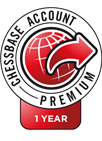Agony & Ecstasy #119
This week's pair of games are by James Coleman, an Englishman in his early forties rated round about 2200. He sent me this note with them:
I just thought I'd submit a couple of games for your column. The first (Agony) was against quite a strong player in the London League. He really worked me over big time. For the life of me, I can't remember his name but I do remember his post game comment in the bar: "You didn't really oppose any of my moves", he chastised. He was right as well. A couple of years later, I'd learned from this experience and played quite a decent game in a vaguely similar setup (Ecstasy), against the well-known Serbian trainer IM Slobodan Mirkovic.

James is on the left
When I looked to see if I'd ever played James myself, I discovered that said forgettable strong player was me. I hope I wasn't too bombastic in the bar and at least paid for the drinks. I always make some notes after London League games, and so I've slightly modified what I did for myself and added some written notes as explanation.
All the notes in both games are mine.
Click or tap the second game in the list to switch
Every pawn structure has its typical plans and to know these plans helps you to find your way in these positions. On this DVD Mikhalchishin presents and explains the most common central structures: The Hedgehog, the Maroczy, Hanging pawns and the Isolani.
Submit your games and win free Premium!
 Order the annual ChessBase Premium Membership and save twice! You only pay for ten months Premium and you get a 13th month for free. Payment only by credit card. The subscription is automatically renewed on the expiration date.
Order the annual ChessBase Premium Membership and save twice! You only pay for ten months Premium and you get a 13th month for free. Payment only by credit card. The subscription is automatically renewed on the expiration date.Did you enjoy the column and instructive analysis by GM Jonathan Speelman? Do you wish you could have a world-renowned grandmaster analysing your play? You can!
To submit your games just upload a PGN or ChessBase file (.pgn or .cbv archive), along with your name and e-mail address. Send one success story (Ecstasy) and one loss (Agony).
Tell why you chose them, where or when they were played. Please do include your email address, so Jon can reply, and preferably a photo of yourself for our article.
If your game is selected Jon will contact you personally, and not only will you get free detailed commentary of your games by one of chess’s great authors and instructors, and former world no. 4 player, but you also win a free three-month ChessBase Premium Account!
A three-month Premium subscription to ChessBase Account means you get:
- Premium access to the Playchess server with ratings, simuls, lectures, and live commentary of top games
- Access to all Web apps with no restrictions, such as the Cloud database, and more!
- Full access to the Video archive, which not only includes all the past lectures by Daniel King, Simon Williams and others, but also many full ChessBase products you would normally need to buy in the ChessBase Shop but that you can view for free as a Premium subscriber.
See also:
























